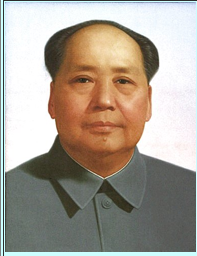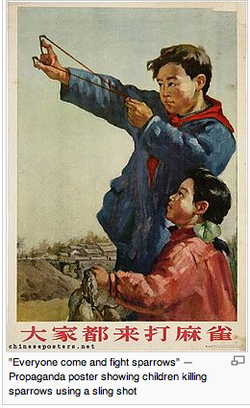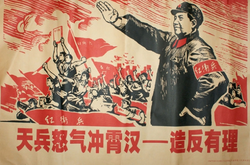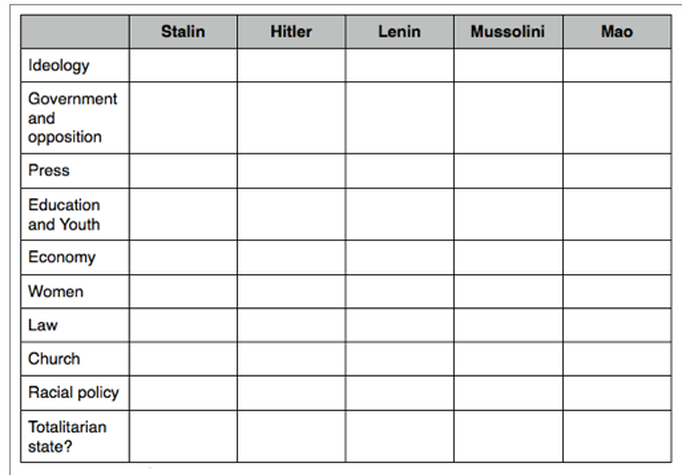1. Mao’s rise to power
On October 1st 1949 Mao declared the People’s Republic of China in Tiananmen Square.
ATL Skills: Knowledge and Thinking. Make a poster mind map to answer the question:
CAUSATION: Analyse the factors that enabled Mao to rise to power in China by 1949.
Mao Rise to power – Todd and Waller
2. Mao Consolidation of Power (Transition to a Socialist State)
What problems did China face in 1949?
Mao Consolidation of Power Key Note
Extract from The Impact of Chairman Mao: China 1946 – 1976
Consolidation of power
Consolidation of Power part 1
Consolidation of Power part 2
Chinese Posters
The article below is from History Review and compares the rise of Stalin and Mao.
History Review: Stalin and Mao
- Create a table with the problems Mao faced in one column and the actions he took to overcome it in the next. The third column is for a comment on the success of Mao’s action.
-
Problems faced by Mao in 1949 Actions taken by Mao Comment on success of Mao’s action Political Social Economic Foreign Relations Implementation of ideology - These are the methods that Mao used to consolidate his power: coercion,terror, political reform, economic reform, social reform, military tactics and mass mobilisation campaigns. For each one give two clear examples of what Mao did to consolidate his power using that method. Were there any other methods?
- Use the information above to make a comparison between the methods used by Hitler and Mao to consolidate their power. Can you devise a Venn diagram to illustrate these points?
Hundred Flowers Campaign

The Hundred Flowers Campaign
First Five Year Plan and 100 flowers Campaign
ATL Skills: Thinking – Making Thinking Visible (Ron Ritchardt)
Complete a Peel the Fruit routine. Your goal is to explore the factors that enabled Mao to consolidate his power between 1949 and 1957.
Complete the thinking routine using the instructions below:
1. Title is: Mao’s consolidation of Power 1946 – 56
2. Starting from the outside of the fruit:
(i) what actions did Mao take? (ii) what questions have you got? (iii) Perspectives: what different perspectives do we have of the actions taken by Mao to consolidate his power? (iv) Choose 3 actions that he took and explain why he did them (v) How do the actions taken by Mao to consolidate his power connect to what I know about other Single Party State Leaders?
3. In the centre: Make a comment about what you have found out about Mao’s consolidation of power (perhaps the methods, success, nature, necessity)
3. Successes and failures in economic development: First Five Year Plan and Great Leap Forward
http://www.bbc.co.uk/programmes/b00bw51j
The Great Leap Forward
Michael Lynch – General Steel
Michael Lynch – General Grain
The Effects of the Great Leap Forward
The Great Leap Forward
4. Social Reforms
 Mao made several social reforms. Read the document below. For each of the reforms state:
Mao made several social reforms. Read the document below. For each of the reforms state:
Socratic Seminar
To what extent do you agree that control of the population was the main motive behind Mao’s domestic policy 1949 – 1961?
Decide on the position you would like to take in this seminar. In your teams list the key points of your arguments. Find evidence to support your points in the form or events, historiography or data.
5. Cultural Revolution
What methods did Mao use to restore his power after 1965?

The beginning of the Great Purge by Jung Chang from Mao, an unknown history
The Cultural Revolution
The Cultural Revolution
Perspective: What are the different perspectives on Mao’s reasons for launching the Cultural Revolution?
Here is a link to a BBC site with lots of information about the cultural revolution:
http://news.bbc.co.uk/hi/english/static/special_report/1999/09/99/china_50/cult.htm
http://edition.cnn.com/SPECIALS/1999/china.50/inside.china/profiles/lin.biao/
http://www.biography.com/people/jiang-qing-9354625
Effects of the Cultural Revolution by Lynch
Mao and the Cultural Revolution
1. Use of the PLA
2. Death of Lin Biao and reaction to it
3. Decline and death of Mao
4. Return of Zhou Enlai and Deng Xiaoping
Continuity: The impact of the Cultural Revolution (social, cultural and political):
Impacts of the Cultural Revolution
Analysis of the Cultural Revolution:Shared Word Document: Analysis of the Cultural Revolution through concepts
7. Historiography
China and the Historians
8. Foreign Affairs 1949 – 1976 (HL only) 
What big events took place during this time period?
- Brainstorm a list of major world events from this time period. How do they connect to your list of questions? Do you need to revise the questions?
What do you need to know?
- Make a list of questions on your own of what you need to find out to understand Chinese foreign affairs in this time period. Each question must contain one of the five concepts: Change, Continuity, Consequence, Perspective, Significance
- Compare them to the others in your group and decide on a final list of questions that you will find the answers to.
Research the answers to your questions.
Produce a Pecha Kucha presentation for the rest of the class to showcase your findings.
Hint: consider the following…
Sino-American relations; establishment and breakdown of Sino–Soviet
relations/conflicts; China as a global power
China and the Superpowers (Canon M, Jones -Nerzic R, et al. 2009. 20th Century World History Course Companion. Oxford: UK)
Crash course: China and the Cold War
Mao goes global (Jung Chang (2005) Mao the Unknown Story )
China’s foreign policy in the context of the Cold War (The Cold War, Pearson)
Carry out the thinking routine Connect – Extend – Challenge on the section about the Sino -Soviet split from this website:http://www.ibiblio.org/chinesehistory/contents/03pol/c05s04.html
Here are the power points created by the class of 2016:
Suraj Solange Elissa Jonas Tara
Complete an essay scaffold for this essay title from the November 2013 Paper 3:
Evaluate the foreign policy of China’s government between 1949 and 1976
9. Single party state leaders – a comparison
Complete this to enable a quick overview and comparison of the different single party state leaders we have studied.
Here is a definition ofTotalitarianism.Here is a past paper question that you need to use a grid like the one above for.
‘The aims and policies of single party state leaders rarely follow their declared ideology.’ To what extent do you agree with this assertion?
